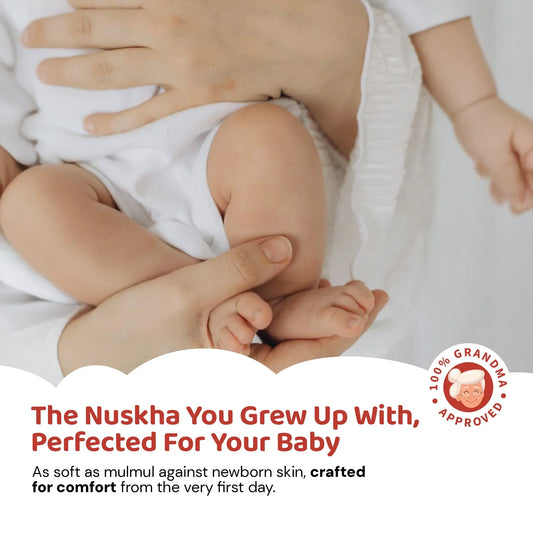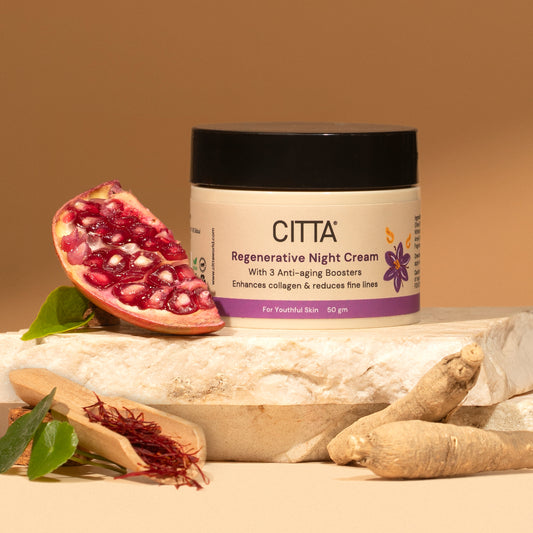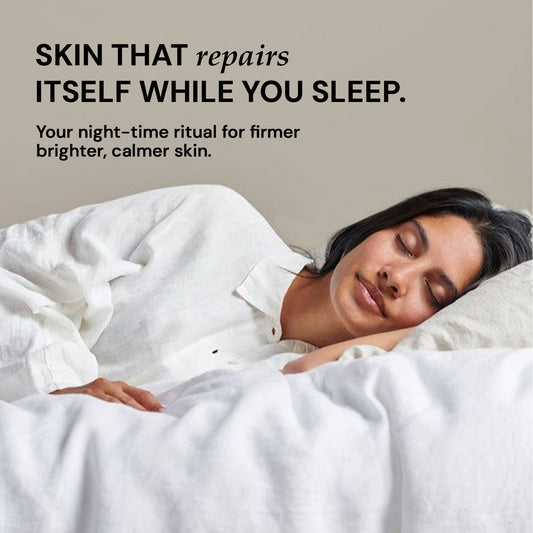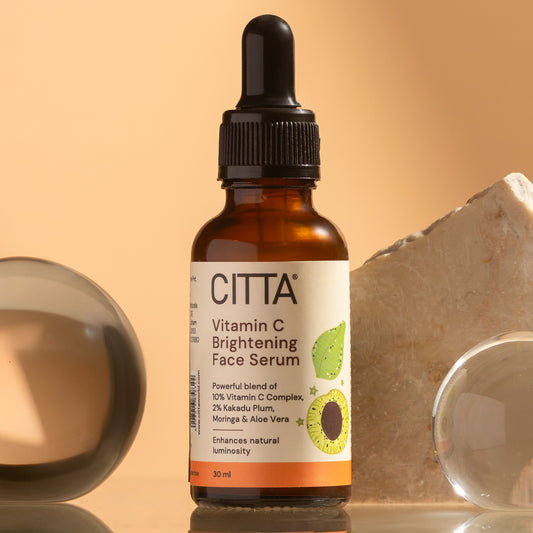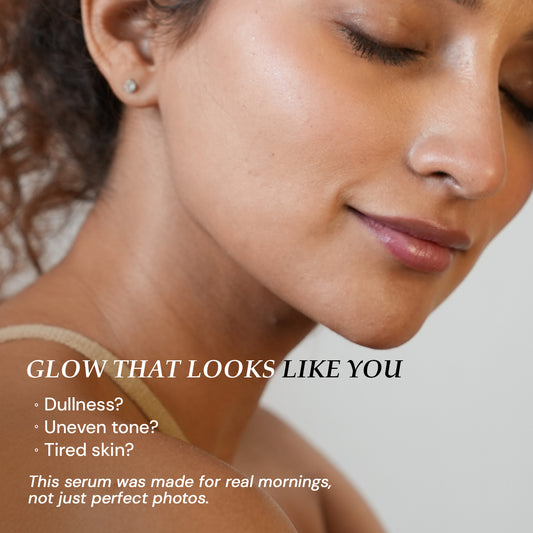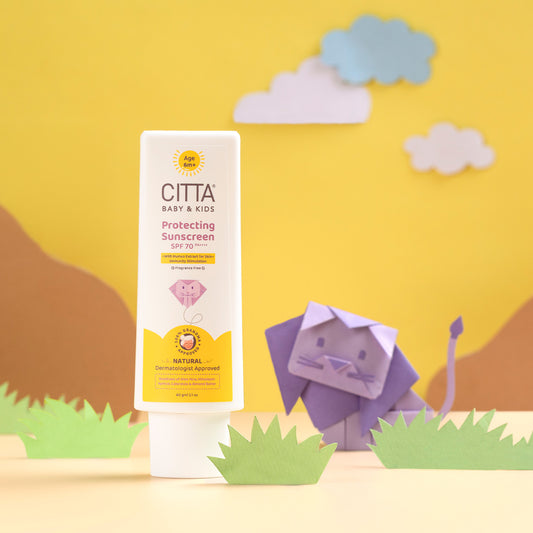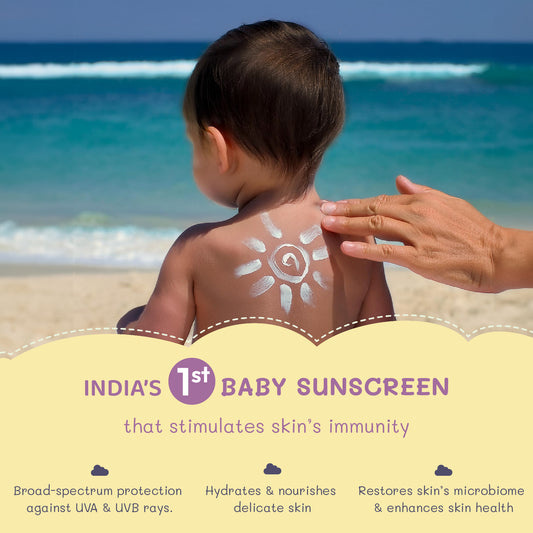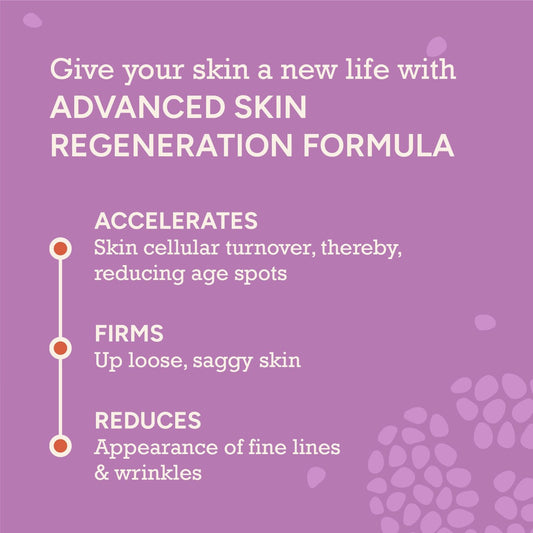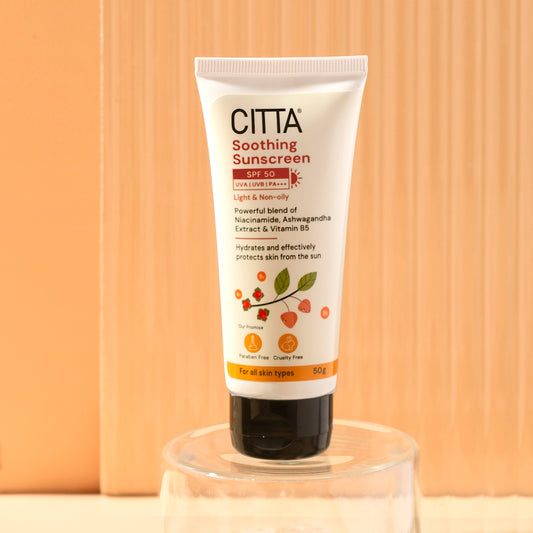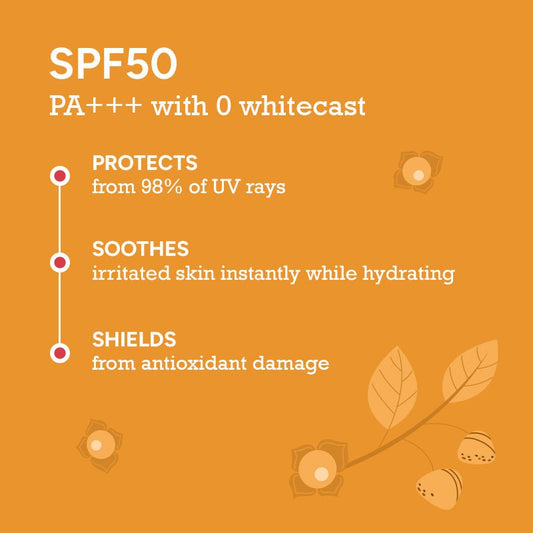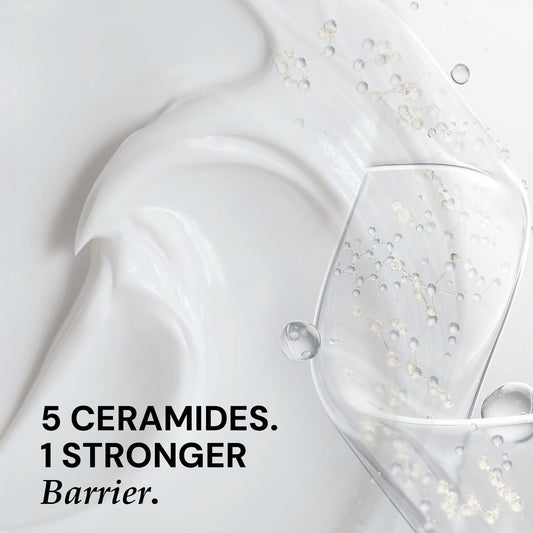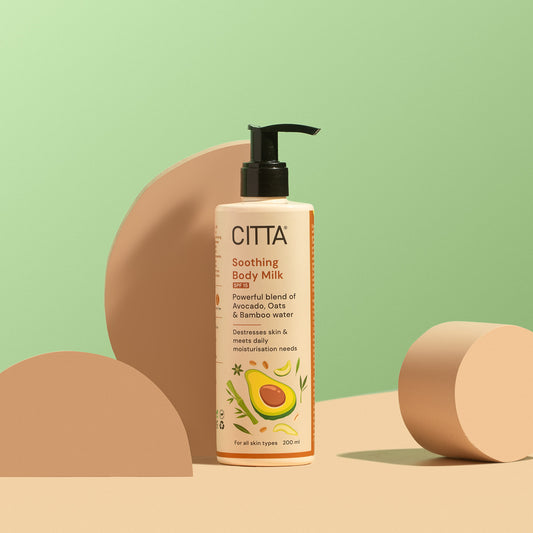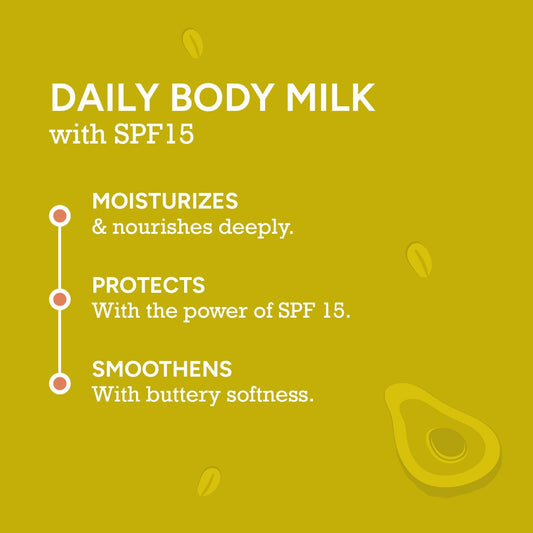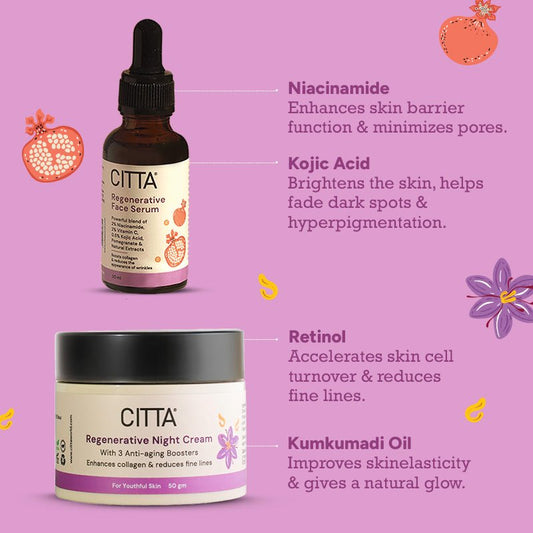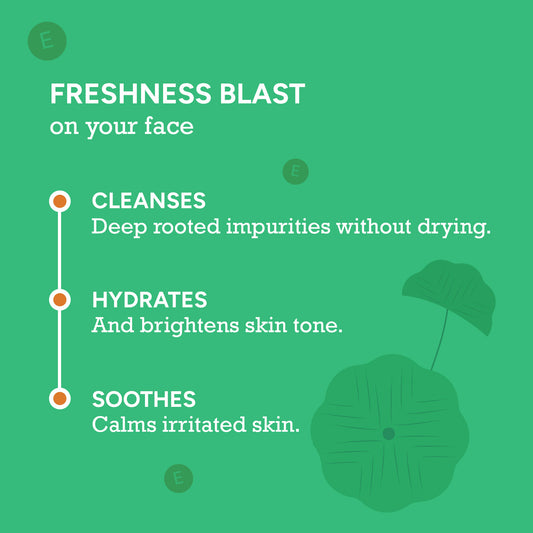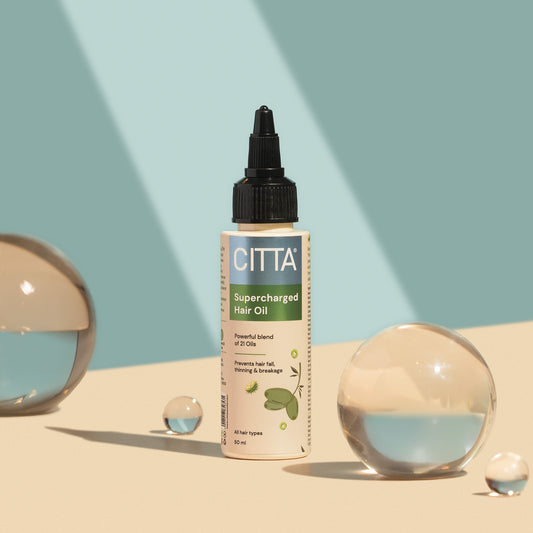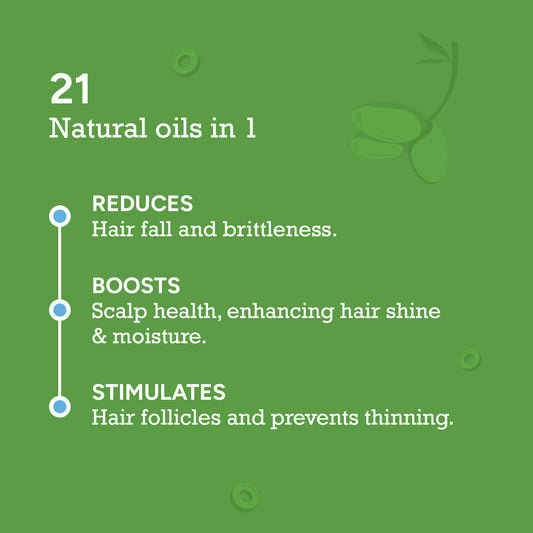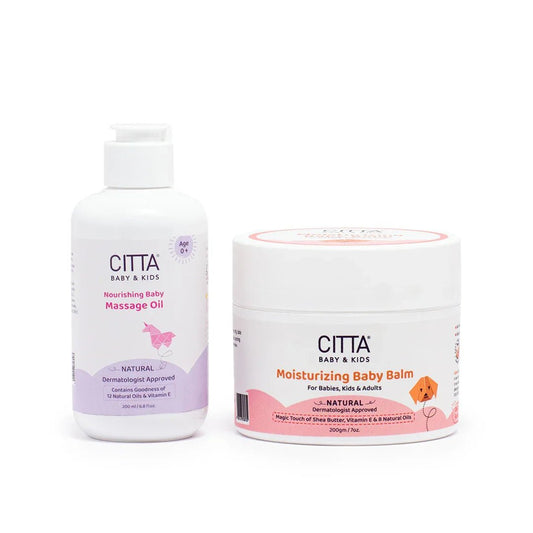The CITTA Promise, Safety First
Toxin Free
Sulphate (SLS/SLES) Free
No Harsh Chemicals
Mineral oil-free
Paraben Free
Natural
Allergen-Free
IFRA Certified Fragrance
Our Bestsellers
-
Natural Baby Moisturizer Balm for Dry, Sensitive Skin
India’s first-ever ‘moisturizing baby balm’ | Heavy-duty moisturizer | Fights dryness & flakiness | For dry, very dry & flaky skin
73 reviewsRegular price Rs. 1,099Regular priceUnit price / perRs. 1,099Sale price Rs. 1,099Regenerative Retinol Night Cream with Kumkumadi & Cica | Anti-Aging & Brightening
Reduces lLines, Wrinkles|Firms Skin|Revives Glow
22 reviewsRegular price Rs. 749Regular priceUnit price / perRs. 0Sale price Rs. 74912% Vitamin C Serum | With Hyaluronic Acid for Brightening & Pigmentation
Triple brightening / Boosts collagen / Evens skin
14 reviewsRegular price Rs. 549Regular priceUnit price / perRs. 0Sale price Rs. 549SPF 70 PA++++ Sunscreen Lotion for Babies & Kids
Protects against UVA & UVB rays | Prevents sunburns | Intensely moisturizes | Stimulates skin immunity
17 reviewsRegular price Rs. 849Regular priceUnit price / perRs. 849Sale price Rs. 849Skin Care (New Launch)
-
Regenerative Retinol Night Cream with Kumkumadi & Cica | Anti-Aging & Brightening
Reduces lLines, Wrinkles|Firms Skin|Revives Glow
22 reviewsRegular price Rs. 749Regular priceUnit price / perRs. 0Sale price Rs. 749Anti Aging Face Serum – With Kojic Acid, Niacinamide & Vitamin C for Glow, Firmness & Youthful Skin
Reduces wrinkles / Firms skin / Revives dullness
6 reviewsRegular price Rs. 549Regular priceUnit price / perRs. 0Sale price Rs. 549Soothing Sunscreen SPF 50 PA+++ | With Niacinamide & Hyaluronic Acid | No White Cast – For Dry and Sensitive Skin
SPF 50 PA+++ | No White Cast | Non-Sticky
7 reviewsRegular price Rs. 579Regular priceUnit price / perRs. 0Sale price Rs. 579Ceramides & White Tea Moisturiser | Barrier Repair with 5 Ceramides + Natural Glow Boost
Repair's Skin Barrier | Deep Moisturization | Rich Antioxidant Protection |
13 reviewsRegular price Rs. 629Regular priceUnit price / perRs. 0Sale price Rs. 629Soothing Body Milk with SPF | Lightweight Body Lotion for Summer Hydration
Daily Moisturization | SPF 15 | Smooth & Soft skin
9 reviewsRegular price Rs. 319Regular priceUnit price / perRs. 0Sale price Rs. 319CITTA Regenerative Face Serum & Night Cream Combo
Reduces fine lines | Firms skin | Fades dark spots & hyperpigmentation
9 reviewsRegular price Rs. 973Regular priceUnit price / perRs. 1,298Sale price Rs. 973Gentle Face Wash for Sensitive Skin | Cica Face Cleanser
Gently Cleanses / Brightens, Soothes Skin / Non-drying
8 reviewsRegular price Rs. 449Regular priceUnit price / perRs. 0Sale price Rs. 4491 / of 7

Why Choose CITTA?
At CITTA, we’ve got everything your little one’s skin could ever need
And then some!
Safety? Absolutely.
100% transparency? You bet.
Innovative skincare solutions? Of course!
And the best part? Everything we do is rooted in dadi nani ke nuskhe, those time-tested remedies passed down through generations which are tested and approved by dermatologists. read more

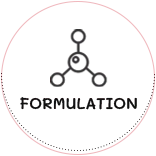

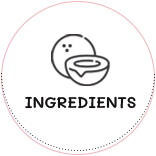

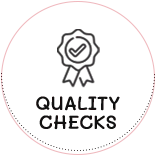

Most-Loved Baby Must-Haves!

-
12% Vitamin C Serum | With Hyaluronic Acid for Brightening & Pigmentation
Triple brightening / Boosts collagen / Evens skin
14 reviewsRegular price Rs. 549Regular priceUnit price / perRs. 0Sale price Rs. 54921-in-1 Supercharged Hair Oil | Amla, Bhringraj & Olive for Hair Growth & Hair Fall Control – with Scalp Applicator
Strengthens & repairs | Promotes growth | Boosts scalp health
8 reviewsRegular price Rs. 293Regular priceUnit price / perRs. 0Sale price Rs. 293All-Rounder Winter Care Duo
12 reviewsRegular price Rs. 1,499Regular priceUnit price / perRs. 1,999Sale price Rs. 1,499Anti Aging Face Serum – With Kojic Acid, Niacinamide & Vitamin C for Glow, Firmness & Youthful Skin
Reduces wrinkles / Firms skin / Revives dullness
6 reviewsRegular price Rs. 549Regular priceUnit price / perRs. 0Sale price Rs. 549Whispers of a Mother’s Heart
"My daughter has been using CITTA since birth, and now there is no going back. The moisturising baby balm has been more than perfect for us. This is a must-have product if your baby has dry skin and rashes."

Smita P.
"To all the moms out there, I would highly recommend this product as it keeps my baby's skin supple and retains moisture, even after the bath. My girl's Paediatrician has also suggested continuing with other CITTA products."

Ananya N.
"It has all the oils like sesame, olive, coconut, almond, etc, I am happy as it helps in nourishment, is non-sticky free from fragrance. Love this.."

Rohini G.
This baby bath set prevents dryness and irritation and cleanse gently. Nice product

Nayan T.
Buzz Worth Talking About








From Our Experts to You
Read MoreTrusted Insights and Tips to Nurture Your Baby’s Growth and Happiness
 February 9, 2024
February 9, 2024
The Delicate Balance of Children's Skin: Why Adult Skincare Isn't Suitable
Read More February 9, 2024
February 9, 2024
The Delicate Balance of Children's Skin: Why Adult Skincare Isn't Suitable
Read More February 9, 2024
February 9, 2024
The Delicate Balance of Children's Skin: Why Adult Skincare Isn't Suitable
Read MoreAlso Available at





Parenting Wisdom 101
-

Baby Skin Care Tips Every New Parent Should Know
There’s nothing softer, purer, or more precious than your baby’s skin. But that also means it’s more delicate and vulnerable - to dryness, rashes, and irritation. As new parents, you...
Baby Skin Care Tips Every New Parent Should Know
There’s nothing softer, purer, or more precious than your baby’s skin. But that also means it’s more delicate and vulnerable - to dryness, rashes, and irritation. As new parents, you want to give your baby the gentlest care possible - something safe, effective, and inspired by the wisdom of generations. At CITTA, we believe that baby skincare should be a mindful ritual - rooted in dadi-nani ke nuskhe, yet perfected with modern dermatological science. Here’s your dermatologist-approved guide to understanding, protecting, and nourishing your little one’s skin naturally. 1. Understand Your Baby’s Skin A newborn’s skin is thinner and more sensitive than an adult’s, making it prone to dryness and irritation. Their skin barrier is still developing, so using gentle, chemical-free, and pH-balanced products is essential. CITTA Tip: Choose products that are free from parabens, sulfates, silicones, and synthetic fragrances.Try: CITTA Natural Foaming Baby Wash - made with Coconut Oil, Aloe Vera, and Rice Protein, this gentle cleanser maintains skin’s natural pH while preventing rashes and dryness. 2. Moisturize Daily - The Secret to Rash-Free, Baby-Soft Skin Moisturizing is the most crucial baby skin care step. A rich, oil-based formula helps lock in hydration and strengthen the skin barrier. CITTA Tip: Always apply moisturizer right after bathing to seal in moisture.Try: CITTA Natural Moisturizing Baby Balm - a luxurious blend of 7 natural oils, Shea Butter, and Vitamin E that keeps your baby’s skin soft, rash-free, and nourished all day. 3. Choose the Right Bath Routine Your baby’s skin is delicate and loses moisture quickly. Keep bath time short - around 5 to 10 minutes, and use only lukewarm water. Avoid strong soaps or bubble baths that can dry out the skin. Instead, choose a gentle, pH-balanced baby wash like CITTA Gentle Foaming Baby Wash to cleanse while maintaining your baby’s natural oils. 4. Prevent Diaper Rashes Naturally The diaper area stays warm and moist, making it prone to rashes and irritation. To keep your baby comfortable, change diapers frequently, gently clean the area, allow diaper-free time daily, and apply a soothing, protective cream like CITTA Diaper Rash Cream to prevent redness, dryness, and discomfort while nourishing delicate skin. 5. Protect from Environmental Stressors Dust, pollution, and sun exposure can easily irritate your baby’s sensitive skin. Keep your baby indoors during peak sun hours and always use breathable, cotton clothing. CITTA Tip: For outdoor time, apply a gentle baby-safe sunscreen.Try: CITTA Protecting Baby Sunscreen SPF 70 PA+++, crafted with Zinc Oxide, Aloe Vera, and Shea Butter, it provides safe, non-sticky sun protection for delicate skin. 6. Massage for Healthy Skin & Better Sleep Baby massages are more than just bonding moments, they play a crucial role in improving blood circulation, strengthening muscles, and promoting better sleep. Regular gentle massages with nourishing oils like coconut or almond oil also help keep your baby’s skin soft, supple, and healthy. CITTA Tip: Warm the oil slightly before massage and use gentle, circular motions.Try: CITTA Nourishing Baby Massage Oil - enriched with Coconut, Almond, and Turmeric oils, this traditional blend improves circulation, promotes relaxation, and strengthens the skin’s natural barrier. 7. Keep Your Baby Hydrated (Inside & Out) Even though babies get most of their hydration from milk, their skin needs external hydration support too - especially during dry seasons. Use a natural face mist or moisturizer throughout the day if the skin feels dry. Try: CITTA Hydrating Face Mist with Rose & Aloe Vera - safe for babies and adults alike, this gentle mist instantly refreshes and soothes the skin. 8. Patch Test Every New Product Even natural ingredients can cause reactions if your baby’s skin is sensitive to them. Always do a small patch test on your baby’s inner arm or thigh before applying any new product all over. Because WHY NOT? Give Your Baby the Care They Deserve At CITTA, we’ve got everything your little one’s skin could ever need, and then some!Safety? Absolutely.100% transparency? You bet.Dermatologist-tested and inspired by grandma’s wisdom - that’s the CITTA way. When you choose CITTA, you’re not just choosing skincare; you’re choosing mindful care backed by love, science, and generations of trust. FAQs 1. What are the most important baby skin care tips for newborns? Keep baths short, use mild cleansers, moisturize daily, and protect from harsh sunlight and rashes. 2. Which baby skincare products are best for sensitive skin? Use dermatologist-tested products like CITTA Baby Balm, CITTA Baby Wash, and CITTA Baby Massage Oil - all made from natural, chemical-free ingredients. 3. How often should I bathe my newborn? 3–4 times a week is enough for newborns. Over-bathing can cause dryness. 4. Can I use regular lotion on my baby? No. Baby skin is more delicate, so always use a product specifically formulated for babies, like CITTA Moisturizing Baby Balm. 5. How can I prevent diaper rashes? Keep the area clean and dry, change diapers often, and apply CITTA’s Natural Baby Balm after every change. 6. Are natural or Ayurvedic baby products safe? Yes, as long as they’re dermatologically tested and free from harmful chemicals. CITTA blends Ayurveda with science to ensure safety. 7. Can I use baby products on my own skin? Absolutely! CITTA’s baby range is gentle, nourishing, and perfect for adults with sensitive skin too. 8. When should I start using baby skincare products? You can begin from day one, as long as the products are safe, natural, and dermatologist-approved, like CITTA’s newborn-safe range.
Read More -

Castor Oil vs Coconut Oil for Baby Massage – Wh...
In every Indian household, baby massage is more than just a daily ritual; it’s an age-old tradition rooted in love and wisdom. From dadi-nani ke nuskhe (grandmother’s tips) to modern...
1 commentCastor Oil vs Coconut Oil for Baby Massage – Which Is Better?
In every Indian household, baby massage is more than just a daily ritual; it’s an age-old tradition rooted in love and wisdom. From dadi-nani ke nuskhe (grandmother’s tips) to modern dermatologists’ recommendations, parents have always looked for the best oil for newborn massage that keeps their baby’s skin soft, strong, and healthy. Among the many choices, two oils always spark debate: castor oil for baby massage and coconut oil for baby massage. Both are trusted, both are natural, but which one is truly better for your little one? Let’s dive in. Why Baby Massage Matters In India, baby massage is not just skincare; it’s an emotional bonding experience. Traditionally done every morning, it is believed to: Strengthen muscles and bones Improve blood circulation Aid digestion and sleep Nourish and protect delicate skin And of course, the choice of oil makes all the difference. Coconut Oil for Baby Massage Coconut oil is one of the most commonly recommended oils for baby massage, especially in tropical climates. Benefits of Coconut Oil for Baby Massage: Light & Non-Sticky: Quickly absorbed by delicate skin, making it ideal for daily use. Cooling Effect: Naturally soothes the skin, perfect for summers or hot weather. Skin Protection: Its antimicrobial properties help reduce the chances of skin infections. Hair & Scalp Care: Helps reduce dryness and keeps the scalp nourished. Gentle on Sensitive Skin: Less greasy, making it a favorite among parents worldwide. However, coconut oil may not provide enough nourishment in harsh winters when skin tends to get extra dry. Castor Oil for Baby Massage Castor oil has been trusted for generations, especially during winter or when babies have dry skin. Benefits of Castor Oil for Baby Massage: Deep Nourishment: Rich in fatty acids that moisturize deeply. Strengthens Muscles & Bones: A popular choice in traditional massage routines. Soothes Irritation: Known for its anti-inflammatory properties. Hair Growth Support: Helps strengthen roots and promote healthy hair. But unlike coconut oil, castor oil is thicker and stickier, which may feel heavy during hot or humid weather. If you’d like to explore more about castor oil’s skin benefits, check our detailed guide: 5 Surprising Benefits of Using Castor Oil for Baby Skin Care. Castor Oil vs Coconut Oil – The Key Difference When deciding between castor oil and coconut oil for baby massage, the difference lies in texture, climate suitability, absorption, and specific skin needs. Texture: Coconut oil has a light and smooth consistency, making it easy to spread and massage into your baby’s skin without leaving residue. Castor oil, on the other hand, is thicker and denser, giving a richer, more protective layer on the skin. This makes castor oil especially beneficial for babies with dry or flaky skin. Climate Use: Coconut oil naturally provides a cooling effect, which is why it is the go-to choice for hot and humid climates. It keeps the skin fresh and non-sticky even during summer. Castor oil works best in cold or dry climates because its heavier texture helps lock in moisture and prevent the skin from drying out in the winter months. Absorption: Coconut oil is known for its fast absorption, quickly sinking into the skin without greasiness. This makes it ideal for daily massages, even if you’re short on time. Castor oil, however, takes longer to absorb, but in return, it offers deep moisturization that lasts longer, creating a protective barrier against dryness. Skin Concerns: Coconut oil is more suited for normal to sensitive skin types, thanks to its gentle, soothing, and antimicrobial nature. Castor oil is best for babies with very dry, rough, or flaky patches, as it delivers intense hydration and helps calm irritation. In short: Choose coconut oil if you want a lightweight, cooling, and quick-absorbing option for everyday massage, especially in warmer weather. Choose castor oil if your baby needs deep nourishment, extra hydration, or lives in a colder, drier region. A Thoughtful Alternative – Why Choose One When You Can Have Both? Instead of choosing between the two, many parents prefer a balanced oil that combines the goodness of castor oil, coconut oil, and other natural oils. That’s exactly what you get with CITTA Natural Nourishing Baby Massage Oil. Why Parents Love CITTA: 12 Oils in 1 Blend – Includes Castor oil, Coconut oil, Almond, Sesame, Olive, Sunflower, Ashwagandha, Turmeric, Basil, Brahmi, Cinnamon & Camphor oils. Lightweight yet Nourishing – Absorbs easily without feeling sticky. Season-Friendly – Works equally well in summer and winter. Safe for Babies – Dermatologist-tested, toxin-free, cruelty-free, and allergen-free. Multi-Purpose – Can be used on both skin and hair. With CITTA, you don’t have to worry about choosing; you give your baby the balanced nourishment of both oils in one safe, modern, and effective formula. Add to cart Conclusion When it comes to castor oil vs coconut oil for baby massage, there’s no one-size-fits-all answer. Both are treasures of Indian tradition, each offering unique benefits. But for today’s parents who want safety, nourishment, and convenience in one, CITTA Baby Massage Oil brings the perfect solution, a thoughtful blend of 12 natural oils, inspired by dadi-nani’s nuskhe, designed for modern parenting. Because when it comes to your baby’s skin, why settle for one when you can have it all? FAQs 1. Which is better for newborn massage, coconut oil or castor oil? Coconut oil is lighter, making it more suitable for newborns. Castor oil can be used occasionally in winter for extra nourishment. 2. Can I mix castor oil and coconut oil at home? Yes, but getting the right balance and purity can be tricky. A pre-formulated blend like CITTA Baby Massage Oil ensures safety and consistency. 3. Is coconut oil enough for dry baby skin? It works for mild dryness, but for very dry skin, castor oil or a multi-oil blend is better. 4. Can castor oil be used in summer? It’s safe but may feel heavy on your baby’s skin in hot weather. Coconut oil or a lightweight blend is preferable. 5. What’s the best oil overall for baby massage? A dermatologist-approved blend that combines coconut, castor, and other nourishing oils, like CITTA Natural Nourishing Baby Massage Oil, offers complete care.
Read More1 comment -

Natural Moisturizer for Baby Dry Skin: What Eve...
As parents, we understand how delicate and soft our baby’s skin is. However, it is also more likely to experience dryness, flakiness, and irritation, especially during seasonal changes, frequent baths,...
Natural Moisturizer for Baby Dry Skin: What Every Parent Should Know Before Buying
As parents, we understand how delicate and soft our baby’s skin is. However, it is also more likely to experience dryness, flakiness, and irritation, especially during seasonal changes, frequent baths, or exposure to pollution. Finding the best natural moisturizer for a baby's dry skin is not just about skincare; it is about protecting their health and comfort. With so many options available, how do you choose the right natural moisturizer for your baby's dry skin? Let’s break it down for you with everything you need to know before making that purchase. Why Does Your Baby’s Skin Need a Natural Moisturizer? Unlike adult skin, your baby’s skin is up to 30% thinner and far more delicate. This means it loses moisture at a much faster rate and doesn’t have the same natural oils or resilience to protect itself from the environment. That’s why even small changes, like a slightly cooler bath, exposure to wind, or spending a few hours in air-conditioning, can leave their skin feeling dry, itchy, or irritated. A good baby moisturizer plays a crucial role in daily care: Restores lost hydration after baths: Bathing often strips away natural oils. A moisturizer helps replenish this lost hydration and prevents the skin from drying out. Strengthens the skin’s natural barrier: Babies are still developing their protective skin barrier. Moisturizers enriched with natural butters and oils create a shield against external irritants. Prevents flakiness, rough patches, and redness: Without moisture, baby skin can quickly become rough or patchy. Regular moisturization helps keep it smooth and irritation-free. Keeps skin soft, supple, and healthy all day long: Hydrated skin is not only comfortable but also better protected against rashes, eczema, or environmental triggers like pollution and seasonal dryness. This is why choosing a natural moisturizer for a baby's dry skin is so important. Unlike chemical-heavy products, natural formulations are gentle, toxin-free, and safe for everyday use, ensuring that nothing harsh touches your baby’s sensitive skin. Discover CITTA’s Moisturizing Baby Balm - enriched with nourishing natural butters and oils, designed especially to protect and comfort delicate baby skin. Key Ingredients to Look For in the Best Natural Moisturizer for Baby Dry Skin When selecting a moisturizer for kids, ingredients matter more than fancy packaging. Look for: Shea Butter & Cocoa Butter: Deeply hydrating natural butters that keep skin soft. Coconut Oil & Sunflower Oil: Gentle oils that restore skin moisture without greasiness. Oat Kernel Extract: Soothes irritation and calms redness. Chamomile: Known for its anti-inflammatory and healing properties. Vitamin E: Helps protect delicate skin from dryness and oxidative stress. These ingredients make a baby balm not only nourishing but also safe for daily use. Why CITTA’s Moisturizing Baby Balm is the Best Choice At CITTA, we believe baby skincare should be safe, effective, and rooted in dadi-nani ke nuskhe blended with modern science. Our Moisturizing Baby Balm is specially formulated to be the best baby moisturizer for dry skin. What makes it unique? Natural & toxin-free: Free from parabens, silicones, and harsh chemicals. Dermatologist-tested & safe: Suitable for newborns, toddlers, and kids up to 10 years. Deep hydration: Works as a moisturizing balm that keeps skin nourished all day long. Multi-purpose use: Perfect for face, hands, knees, and any dry patches. This gentle yet effective moisturizer for kids ensures your baby’s skin stays soft, happy, and protected every single day. Add to cart How to Use a Natural Moisturizer for Baby Dry Skin After Bath: Apply the baby moisturizer immediately after drying the skin to lock in moisture. Before Bedtime: Massage gently with the moisturizing balm to keep skin nourished overnight. Focus on Dry Areas: Pay extra attention to elbows, knees, and cheeks that dry out faster. Daily Use: Consistency is key to preventing dryness. Final Thoughts Choosing the best natural moisturizer for a baby's dry skin doesn’t have to be hard. Look for products that are safe, natural, dermatologist-tested, and made for delicate skin. With CITTA’s Baby Balm, you get the perfect mix of tradition and science, crafted to keep your little one’s skin soft, hydrated, and healthy. Try CITTA Moisturizing Baby Balm today and give your baby’s skin the gentle care it deserves. FAQs 1. Can I use a natural moisturizer for my newborn’s dry skin? Yes, a safe and dermatologist-tested baby moisturizer can be used even on newborns. Always choose a formula free from harsh chemicals and artificial fragrances. 2. How often should I apply moisturizer to my baby? At least twice a day, once after a bath and once before bedtime. You can reapply on very dry patches whenever needed. 3. What is better for the baby's skin, lotion or moisturizing balm? A moisturizing balm is thicker and more nourishing, making it ideal for dry skin. Lotions are lighter but may not be enough for persistent dryness. 4. Can I use adult moisturizers on my baby? No. Adult products often contain strong fragrances and harsh ingredients that can irritate delicate baby skin. Always opt for a specially formulated moisturizer for kids. 5. What makes CITTA’s Baby Balm different from other baby moisturizers? Our CITTA Baby Balm combines grandma’s wisdom with modern dermatology, offering safe, toxin-free, and effective hydration for dry, sensitive skin.
Read More
Glow Guide: Expert Tips & Insights
-

Alpha Arbutin for Skin: Benefits, Uses & Side E...
Dark spots, uneven skin tone, and stubborn pigmentation are some of the most common skincare concerns today. With increasing awareness around safe and effective actives, alpha arbutin for skin has emerged...
Alpha Arbutin for Skin: Benefits, Uses & Side Effects You Should Know
Dark spots, uneven skin tone, and stubborn pigmentation are some of the most common skincare concerns today. With increasing awareness around safe and effective actives, alpha arbutin for skin has emerged as a dermatologist‑recommended ingredient that delivers visible brightening without harsh side effects. But what exactly is alpha arbutin, how does it work, and is it safe for everyday use? Let’s break it down in a simple, science‑backed way. What Is Alpha Arbutin? Alpha arbutin is a plant‑derived skin‑brightening ingredient extracted from bearberry, cranberry, and blueberry plants. It is widely known for its ability to reduce hyperpigmentation and dark spots by gently regulating melanin production in the skin. Unlike aggressive lightening agents, alpha arbutin works without damaging the skin barrier, making it suitable for long‑term use and sensitive skin types. How Does Alpha Arbutin Work on Skin? Alpha arbutin targets pigmentation at its root. It inhibits tyrosinase, an enzyme responsible for melanin (pigment) production. By controlling excess melanin formation, alpha arbutin helps: Fade dark spots and acne marks Reduce sun‑induced pigmentation Improve uneven skin tone Restore natural skin clarity and glow The result is brighter, clearer skin, gradually and safely. The Ultimate Brightening Solution If you are looking for a formulation that captures these benefits while nourishing the skin, our Radiance Gold Serum for Face is the perfect choice. It thoughtfully combines Alpha Arbutin with Niacinamide to provide a dual-action approach to glow and barrier health. Add to cart Also Read: The Hidden Toxins in Your Skincare: 6 Ingredients Dermatologists Say You Must Avoid Key Benefits of Alpha Arbutin for Skin 1. Reduces Dark Spots & Hyperpigmentation Alpha arbutin is highly effective in fading melasma, sun spots, age spots, and post‑acne marks with consistent use. 2. Brightens Skin Tone Naturally By controlling melanin overproduction, it enhances overall radiance without making skin look unnaturally pale. 3. Gentle Yet Effective One of the biggest benefits of alpha arbutin is that it delivers results without irritation, unlike stronger actives. 4. Suitable for Sensitive Skin Its non‑abrasive nature makes it ideal for sensitive, reactive, or compromised skin barriers. 5. Supports Long‑Term Skin Health Alpha Arbutin works gradually, ensuring safer and more sustainable results over time compared to harsh chemicals. Also Read: Glutathione for Skin: Benefits, Results, Side Effects & Myths (Complete Guide) How to Use Alpha Arbutin in Your Skincare Routine For the best results, Alpha Arbutin should be used in a serum format to allow for deep penetration. Morning Routine Gentle cleanser Apply your Radiance Gold Serum Moisturizer And always follow Broad‑spectrum sunscreen (mandatory) Night Routine Cleanser Alpha arbutin serum Moisturizer Tip: Always pair alpha arbutin with sunscreen during the day to prevent new pigmentation. Ingredients That Work Well With Alpha Arbutin Alpha Arbutin performs even better when paired with other skin-loving ingredients: Niacinamide – Improves barrier strength and reduces pore appearance. Hyaluronic Acid – Boosts hydration for a "plump" look. Vitamin C – Enhances overall antioxidant protection. Licorice Extract – calms inflammation and pigmentation At CITTA, we believe in thoughtfully blending such actives with time‑tested natural ingredients inspired by dadi‑nani ke nuskhe, ensuring effectiveness without compromising skin comfort. Are There Any Side Effects of Alpha Arbutin? Alpha arbutin is considered safe and well‑tolerated when used at recommended concentrations (usually up to 2%). However, mild reactions may occur in rare cases: Slight redness or irritation (especially if overused) Tingling on very sensitive skin CITTA Safety Tip: We disclose every ingredient down to 0.01% because we believe informed choices empower confident skincare. Always perform a patch test before introducing a new active into your routine. Is Alpha Arbutin Better Than Hydroquinone? Yes, when it comes to safety. While hydroquinone offers fast results, it is associated with long‑term side effects. Alpha arbutin provides similar brightening benefits but works gently, making it suitable for daily and prolonged use. Who Can Use Alpha Arbutin? Alpha arbutin is suitable for: Men and women All skin types Sensitive and acne‑prone skin People dealing with pigmentation or uneven skin tone Pregnant or breastfeeding individuals should consult a healthcare professional before use. Why Ingredient Transparency Matters At CITTA, transparency isn’t a marketing promise; it’s a responsibility. Every ingredient is disclosed, even at 0.01%, so parents and individuals can make informed skincare choices with complete confidence. Thoughtfully formulated, dermatologist‑tested products allow actives like alpha arbutin to work in harmony with the skin, not against it. Final Thoughts Alpha arbutin is a powerful yet gentle ingredient that fits perfectly into modern, conscious skincare routines. Whether you’re dealing with dark spots, pigmentation, or dullness, it offers a safe, science‑backed solution that delivers visible results over time. When combined with transparent formulations and time‑honoured wisdom, as we believe at CITTA, skincare becomes not just effective, but truly mindful. FAQs: 1. Can alpha arbutin be used daily? Yes, it is safe for daily use when formulated correctly. 2. How long does alpha arbutin take to show results? Visible improvement usually appears within 4–8 weeks of consistent use. 3. Can alpha arbutin be used with vitamin C? Yes, they complement each other well when layered properly. 4. Is alpha arbutin suitable for Indian skin? Absolutely. It works effectively on common pigmentation concerns seen in Indian skin types. 5. Does alpha arbutin lighten skin permanently? No, it evens out skin tone naturally without altering your natural complexion. 6. Can I use it during pregnancy? While Alpha Arbutin is generally considered a safer alternative to hydroquinone, we always recommend consulting your healthcare professional first Also Read: What Are Ceramides? The Unsung Heroes of Healthy Skin (Dermatologist-Approved Guide)
Read More -

10 Anti-Aging Fruits That Make Your Skin Look Y...
Aging is a natural journey, but dullness, fine lines, and tired-looking skin don’t have to be your constant companions. The most effective way to support youthful, glowing skin often begins...
10 Anti-Aging Fruits That Make Your Skin Look Younger – Dermatologists Reveal Why!
Aging is a natural journey, but dullness, fine lines, and tired-looking skin don’t have to be your constant companions. The most effective way to support youthful, glowing skin often begins not in a clinic, but in your kitchen fruit bowl. Dermatologists have long recognized that certain fruits are packed with the exact antioxidants, vitamins, and minerals needed to slow the clock. At CITTA, we call this "Conscious Care." Our philosophy, rooted in the Sanskrit word Chitta, blends Dadi-Nani ke nuskhe (grandmother’s remedies) with modern scientific expertise. Just as these fruits nourish you from within, our formulations nurture your skin from the outside. Here are the 10 powerful anti-aging fruits that boost collagen and keep your complexion looking fresh, firm, and younger than ever. 1. Blueberries - The Ultimate Wrinkle Fighter Blueberries are antioxidant powerhouses. Rich in vitamins A and C, they protect your skin from collagen breakdown caused by pollution and UV exposure. The Benefit: They neutralize free radicals before they can cause fine lines. 2. Mango - The “Skin Repair” Fruit A staple in Indian households for centuries, mangoes are rich in beta-carotene. This helps repair damaged skin cells and provides a natural radiance. The Benefit: Brightens dull skin and supports cellular turnover. 3. Oranges - The Collagen Booster Collagen is the "glue" that keeps skin firm. Oranges provide the Vitamin C necessary to synthesize this essential protein. The Benefit: Stronger skin barrier and reduced pigmentation. 4. Apples - For Firmness + Elasticity Apples contain quercetin, an antioxidant that slows aging at a cellular level, keeping the skin "bouncy." The Benefit: Delayed wrinkle formation and superior hydration. 5. Kiwi - The Glow Fruit Believe it or not, Kiwi has more Vitamin C than oranges! It is a dermatologist's favorite for its ability to reduce oxidative stress. The Benefit: Instant brightness and boosted collagen. 6. Grapes - Nature’s Sunscreen Shield Grapes contain resveratrol, a miracle compound that protects skin from UV damage (though you still need your daily SPF!). The Benefit: Improves smoothness and acts as an internal defense system. 7. Pineapple - Natural AHAs for Baby-Soft Skin Rich in the enzyme bromelain, pineapples gently exfoliate your skin from the inside out, making it look baby-soft. The Benefit: Youthful radiance and even skin tone. 8. Cherries - Anti-Inflammatory Powerhouse Cherries help reduce skin inflammation and puffiness while supporting natural collagen production. The Benefit: Gives a rosy, youthful glow and calms sensitive skin. 9. Watermelon - Hydration + Anti-Aging Together With 92% water content, watermelon keeps skin plump. Dehydrated skin shows wrinkles faster; watermelon prevents this. The Benefit: Prevents dryness-induced fine lines and soothes sun damage. 10. Bananas - The Natural Skin Tightener Bananas contain silica, which is essential for collagen synthesis and maintaining skin structural integrity. The Benefit: Tighter skin and reduced sagging. Also Read: 10 Best Fruits for Skin Glow (Dermatologist-Approved & Science-Backed List!) How to Eat These Fruits for Maximum Anti-Aging Benefits Add them to smoothies Make fruit bowls with mixed berries Eat vitamin-C-rich fruits on an empty stomach Stay hydrated to boost absorption Pair fruits with nuts for antioxidant synergy Pro Tip: While nutrition helps repair skin from the inside, skincare helps protect it from the outside. A combination of both is the real anti-aging secret. Conclusion Nature has always offered powerful remedies for youthful, glowing skin. These 10 anti-aging fruits nourish your skin, boost collagen, and fight early signs of aging, naturally and effectively. At CITTA, we carry this same philosophy into every formulation: Simple, safe, transparent, and rooted in age-old wisdom. Because your skin and your baby’s skin deserve nothing less. Also Read: How to Take Care of Skin in Winter Naturally: The Ultimate Indian Home Remedies Guide FAQs 1. Which fruit is best for anti-aging? Berries, especially blueberries, are among the most powerful due to their high antioxidant content. 2. How often should I eat anti-aging fruits? Daily! A mix of 2–3 fruits a day can significantly improve skin health over time. 3. Do anti-aging fruits really boost collagen? Yes. Fruits rich in vitamin C (kiwi, oranges, berries) support natural collagen formation. 4. Can eating fruit replace my anti-aging skincare routine? Not entirely. Fruits provide the building blocks internally, but products like a Ceramide Moisturizer are needed to protect the skin barrier and lock that nutrition in. 5. Are these anti-aging fruits safe for everyone? Generally, yes, unless you have allergies. Always consume in moderation. Also read: 10 Best Morning Detox Drinks for Glowing Skin (Dermatologist-Approved List!)
Read More -

The Hidden Toxins in Your Skincare: 6 Ingredien...
In 2025, the "Clean Beauty" movement is no longer a trend—it is a necessity. Every time you massage a lotion into your skin or bathe your little one, your body’s...
The Hidden Toxins in Your Skincare: 6 Ingredients Dermatologists Say You Must Avoid
In 2025, the "Clean Beauty" movement is no longer a trend—it is a necessity. Every time you massage a lotion into your skin or bathe your little one, your body’s largest organ absorbs those ingredients directly into the bloodstream. At CITTA, our philosophy is simple: WHY NOT? Why not choose safety? Why not demand 100% transparency? Founded on the Sanskrit principle of Chitta (consciousness), we blend the time-tested "Dadi-Nani ke nuskhe" with modern scientific rigor. Because we believe in complete peace of mind, we disclose every single ingredient, even at 0.01%. To help you make informed choices for your family, here are the 6 hidden toxins in your skincare that dermatologists say you must avoid. 1. Parabens (The Endocrine Disruptors) Found in everything from adult anti-aging creams to baby shampoos, parabens are cheap preservatives used to prevent mold. However, science shows they can mimic estrogen, potentially disrupting hormonal balance. What to look for: Methylparaben, Propylparaben, Butylparaben. The CITTA Safe Choice: Our formulas are entirely paraben-free, relying on safe, innovative alternatives to keep products fresh. 2. Sulfates (SLS & SLES) That "rich lather" in your face wash or baby’s bubble bath often comes from Sodium Lauryl Sulfate. While satisfying, sulfates strip away natural oils and the skin barrier. For babies, this can lead to painful diaper rashes; for adults, it causes premature aging and chronic dryness. The Alternative: Look for "sulfate-free" cleansers that use coconut-based surfactants. 3. Synthetic Fragrances (The "Black Box" Ingredient) A single word-"Fragrance" or "Parfum"-on a label can hide up to 3,000 different chemicals, including phthalates. These are leading causes of skin allergies, dermatitis, and respiratory issues in both infants and adults. The CITTA Standard: We believe in the natural, comforting scents of traditional ingredients, never hidden synthetic cocktails. 4. Mineral Oil & Petrolatum Derived from petroleum, these create a plastic-like film over the skin. While they "lock in" moisture, they also trap toxins and clog pores, preventing the skin from breathing. In babies, this can interfere with the skin’s natural temperature regulation. The Nuskhe Remedy: Use plant-based lipids like those found in our Ceramide Moisturizer to support the skin barrier naturally. 5. Formaldehyde Releasers You won't often see "Formaldehyde" on the back of a bottle, but you will find "Formaldehyde Releasers" like DMDM Hydantoin. These chemicals slowly release small amounts of known carcinogens over time to preserve the product. The Risk: Chronic skin sensitization and long-term health concerns. 6. Oxybenzone (Chemical Sunscreens) Many daily moisturizers with SPF use oxybenzone. Studies suggest it can penetrate the skin and act as a photoallergen. For children, whose skin is 30% thinner than that of adults, these chemicals are absorbed at much higher rates. Safe Alternative: Opt for mineral-based protection (Zinc Oxide or Titanium Dioxide). Why Transparency is the Ultimate Luxury Whether it's our Regenerative Anti-Aging Face Serum for you or our gentle bath range for your little one, we believe you deserve to know exactly what you are putting on your skin. By rooting our products in grandmother's wisdom, those safe, effective remedies passed down through generations, and validating them with dermatological testing, we ensure that safety and efficacy go hand-in-hand. Also Read: Damaged Skin Barrier: Signs, Causes & Dermatologist-Approved Fixes FAQs Q: Are "natural" products always free of these toxins? A: Not necessarily. Some "natural" brands still use synthetic fragrances or parabens. Always check for full ingredient disclosure. Q: Can these toxins affect my baby’s development? A: Ingredients like phthalates and parabens are known endocrine disruptors. Since a baby's system is still developing, avoiding these "hidden toxins" is a proactive way to ensure their well-being. Q: Why does CITTA disclose ingredients at 0.01%? A: Because we believe informed choices empower confident parenting. Even the smallest amount matters when it comes to long-term skin health. Also Read: Chapped Lips: 7 Surprising Reasons Your Lips Stay Dry No Matter What You Apply
Read More
- Choosing a selection results in a full page refresh.
- Opens in a new window.
Create a new wishlist ××Add to Wishlist
{ "items": [ ] }


















